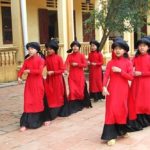The city has implemented a number of policies and initiatives to promote traditional handicrafts, including providing support for training and vocational education, providing funding for research and development, and providing incentives to craftspeople. It has also established a number of organizations to promote traditional crafts and to connect craftspeople with buyers and markets. Hanoi has recognized the vital role that traditional handicrafts can play in its socio-economic development. To this end, the city has implemented policies and initiatives to promote traditional crafts, such as providing financial support for vocational training and research and development, as well as offering incentives to craftspeople. To further support the traditional craft sector, Hanoi has also set up organizations that connect craftspeople with buyers and markets. These organizations strive to ensure the sustainability of traditional handicrafts and to promote the city’s socio-economic development.
Thang Long-Hanoi has long been renowned as the “land of hundreds of crafts”, attracting skilled artisans from all corners of the country. The city’s impressive craftsmanship has served as a driving force for the development of other cultural industries. Unfortunately, traditional crafts are now facing numerous challenges, and it is vital that researchers and policymakers come together to find effective solutions.
Challenges Abound for Traditional Crafts
The art of traditional crafts has been around for centuries, yet it still faces numerous challenges in the modern world. From the increasing cost of materials, to the difficulty of finding skilled labor, to the need to adapt to new technologies, traditional craftsmen often struggle to stay afloat.
What’s more, the lack of education and training opportunities often limit the scope of craftsmanship. Without access to apprenticeships and classes, it can be difficult for craftsmen to advance their skills and reach a wider audience.
At the same time, traditional crafts are becoming more and more popular, as people look to add a touch of authenticity to their homes and lives. As a result, there is a growing demand for crafts that can be both beautiful and functional.
For these reasons, it is vital that we support traditional crafts and the craftspeople who create them. With the right resources, they can continue to make beautiful, one-of-a-kind items that will be treasured for generations to come.
According to Pham Tuan Long, Chairman of the People’s Committee of Hoan Kiem District, the district is located in the heart of the ancient Thang Long Citadel and the modern-day Hanoi capital. It is a convergence of talents and cultures from all over the country, which is also reflected in the district’s street names. Notable streets include Lo Ren, which is named after the local blacksmiths, Hang Thiec, named after the tinsmiths, Hang Bac, named after the silversmiths, and Thuoc Bac, named after the herbal medicine shops.
Each handicraft object is imbued with the character of the natural and social milieu from which it originates, as well as the expertise and spirit of the craftsman, and, more broadly, the imagination of the wider community.
In recent years, traditional crafts have encountered a variety of challenges, including competition from industrially manufactured goods, the influx of low-priced imported products, a lack of human resources to carry on the trade, difficulties obtaining raw materials, and limited opportunities for marketing and consumption.
| Bronze carving is a traditional trade of the capital. Photo: Kinhtedothi.vn |
Craft activities on numerous streets have been drastically reduced due to urbanization, as demonstrated by the growing number of commercial stores not related to the local traditional trade. A survey conducted in 2013 revealed that there were 80 jewelry shops on Hang Bac Street, 70 traditional medicine shops on Lan Ong Street, and 80 silk shops on Hang Gai Street. However, a recent survey revealed that the number had dropped to 40, 35, and 40 respectively.
Long said that traditional crafts need to develop strong partnerships between craftsmen, designers, investors, and entrepreneurs in order to remain viable and competitive in the modern world. Through these collaborations, traditional crafts can build on existing knowledge and create innovative products and services that satisfy the needs of the ever-evolving global marketplace. By joining forces, these four groups can combine their individual skills and resources to create a successful and sustainable enterprise.
“To make handmade products for tourist gifts, production must be based on traditional core values,” Long emphasized, emphasizing the importance of product introduction, trade promotion, attractive designs, and the tastes of both domestic and international consumers.
With extensive experience in preserving and promoting Hang Trong folk painting, Dang Minh Tuan, Chairman of the People’s Committee of Hang Trong Ward, said: “We’ve held events from time to time to provide an overview of this heritage. However, this is not a sustainable method for reviving the painting genre.”
The reasons for underdevelopment in certain regions include a lack of human resources, inadequate support policies, and limited funding sources.
|
Artisan Dang Van Hau finds new materials to make to he products last for long. Photo: VNA
|
To toy figurine maker Dang Van Hau, 38, in Phu Xuyen District, Hanoi, the gradual disappearance of the local traditional craft is a cause for concern. Despite his best efforts to keep the craft alive, Hau is worried that it may not survive for future generations. He is determined to do all he can to ensure that his craft is not lost forever.
For him, making a living during Tet and summer festivals is the most prosperous. However, during the rest of the year, the work available is so scarce that the artisans have to resort to other professions in order to make ends meet. Over time, once they gain stability in their new profession, they become less inclined to return to their traditional craft, according to artisan Dang Van Hau.
Revitalize the Legacy Narrative
The tale of our ancestors and the legacy they left behind is something that should never be forgotten. It is important to remember the past, to recognize the accomplishments of those who came before us, and to continue to honor their memory. By revitalizing the legacy narrative, we can ensure that the stories of our forebears are kept alive and that future generations will be able to appreciate their contributions to our society.
We can do this by researching our family histories, writing down the stories of our ancestors, and sharing these stories with our friends and loved ones. We can also explore our local history, visit museums and historic sites, and learn more about the people and places that shaped our past. By doing so, we can help to keep the memories of our ancestors alive and ensure that their legacy will live on for generations to come.
The seminar was attended by representatives from the municipal Department of Culture and Sports, the Vietnam Cultural Heritage Association, the Vietnam Association for Craft Villages, and the Hoan Kiem District People’s Committee, as well as craft experts, artisans, and artisans from traditional craft villages in Hanoi.
During the seminar, participants discussed ways to protect and promote the development of traditional craft products in Hanoi. They also discussed ways to increase the production capacity of craft villages, enhance the quality of products, and create more markets for traditional craft products. In addition, participants exchanged ideas on how to improve the branding and design of traditional craft products, as well as how to build a network of local and international craft makers to promote Hanoi’s traditional craft products.
At the end of the seminar, the participants agreed that it was essential to raise the bar for Hanoi’s traditional craft products in terms of quality, creativity, and design in order to attract more customers and create more opportunities for craft makers. They also agreed that it was important to promote the value of Hanoi’s traditional craft products through marketing and branding.
| Nguyen Viet Nam of Tired City talks at the seminar. Photo: Ngo Minh |
Many effective solutions have been identified to address the issue of promoting the development of handicrafts, including: increasing the role of design and creativity in the creation process; creating connections between stakeholders; improving marketing and communication strategies; and exploring other potential avenues.
Speaking at the seminar, artisan Dang Van Hau proudly declared that he had successfully crafted materials of exceptional durability and vibrant colors. His toy figurines are not only ingeniously designed, but also tell captivating stories about Vietnamese folklore, making them a perfect memento for any traveler.
He is working with the Vietnam Cultural Heritage Association to develop sustainable products into souvenirs that can last for decades.
The artisan proclaimed that they were supported with packaging design, product demonstration, marketing, and sales, enabling them to concentrate on their creative proficiency.
For the cooperation between artisans and businesses, Nguyen Viet Nam, the Creative Director of the “Tired City” brand, said that it is a great way to creatively tell the story of tradition. Through this collaboration, artisans and businesses have the opportunity to bring their unique stories to life and showcase their shared cultural heritage. This helps to create a bridge between the past and present, making the traditional more relevant to modern audiences. By supporting local artisans, businesses can also help to preserve traditional craftsmanship and promote sustainable growth in their communities.
| Rattan weaving is a traditional trade of Phu Vinh Commune, Chuong My District, Hanoi. |
It is essential to put the customer first and pay close attention to their needs. To do this, it’s important to ask questions that will help you understand the story behind the product. This story should contain value and pride in national culture. Doing so not only helps you to connect with the customer on a deeper level, but it also helps to foster a sense of loyalty.
We need to delve deeper and create compelling stories about handmade products. From the iconic to he, paper fans, conical hats and lacquerware, the story behind them is considered the epitome of traditional craftsmanship,” said Nam.
Sharing the same view, Dr. Le Thi Minh Ly, Vice President of the Vietnam Cultural Heritage Association, emphasized the importance of building a heritage database in a scientific way, with a unified management method, and making it easily accessible in order to create favorable conditions for the creative community to experiment, practice new creations, and bring new values to the heritage.
“By integrating heritage stories into traditional crafts,” said Le Thi Minh Ly, “we can create greater value for the national culture that is captured in souvenirs for international visitors.”
Border guards assist locals in daily life
Over the years, apart from safeguarding the country’s land border, border guards in Phieng Pan border post, Mai Son district, the northern mountainous province of Son La, have been helping the locals improve their livelihood.












